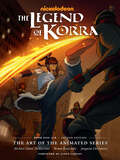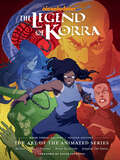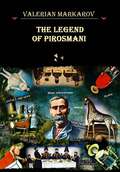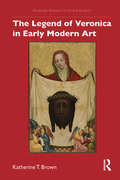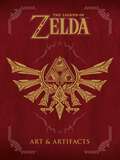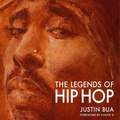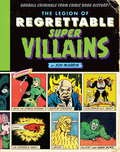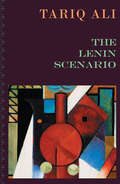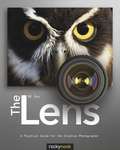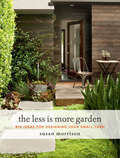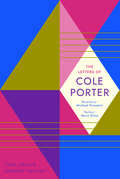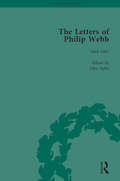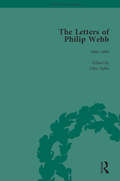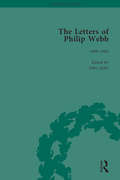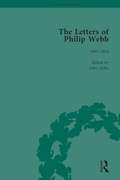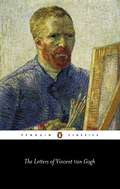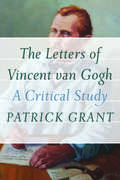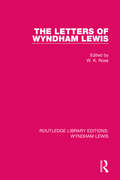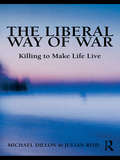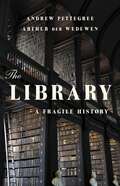- Table View
- List View
The Legend of Korra: The Art of the Animated Series--Book One: Air (Second Edition)
by Michael Dante DiMartino Bryan KonietzkoGo behind the scenes of the animated series Legend of Korra Book One - Air--created by Michael Dante DiMartino and Bryan Konietzko--the smash-hit sequel to their blockbuster show Avatar: The Last Airbender!This digital book contains hundreds of art pieces created during the development of the show's first season, along with new sketches from the original creative team! Featuring creator commentary from DiMartino and Konietzko and a brand-new foreword by Korra voice actor Janet Varney, this is an intimate look inside the creative process that brought a new generation of Avatar heroes to life!Features new to this edition include: All-new cover by Joaquim Dos Santos and Bryan Konietzko! Featuring new sketchbook material by the creators of The Legend of Korra! All-new foreword by Korra voice actor Janet Varney!
The Legend of Korra: The Art of the Animated Series--Book Three: Change (Second Edition)
by Michael Dante DiMartino Bryan KonietzkoGo behind the scenes of the animated series Legend of Korra Book Three––Change, created by Michael Dante DiMartino and Bryan Konietzko. It&’s the perfect way to explore the smash-hit sequel to their blockbuster show Avatar: The Last Airbender! Just in time for the anniversary of the series that stole our hearts, this handsome digital book contains hundreds of art pieces created during the development of the show&’s astonishing third season. Featuring creator commentary from DiMartino and Konietzko, this is an intimate look inside the creative process that brought the mystical world of bending and a new generation of heroes to life! A must-have for any Legend of Korra fan!
The Legend of Korra: The Art of the Animated Series--Book Two: Spirits (Second Edition)
by Michael Dante DiMartino Bryan Konietzko Joaquim Dos SantosGo behind the scenes of the animated series Legend of Korra Book Two - Spirits--created by Michael Dante DiMartino and Bryan Konietzko--the smash hit sequel to their blockbuster show Avatar: The Last Airbender!This handsome hardcover contains hundreds of art pieces created during the development of the show&’s second season, complete with creator commentary from DiMartino and Konietzko. This celebrated second edition also includes pages of new sketches from the original creative team and a brand-new foreword by Korra voice actor P.J. Byrne! This is an intimate look inside the creative process that brought a new generation of Avatar heroes to life, revisited for the show&’s anniversary!
The Legend of Pirosmani
by Valerian MarkarovSometimes amazing people live next to us, whose existence, even before the end of their earthly days, becomes a legend. Such is a lot of the chosen. They, feeding the lofty ideas of humanity, hear, see and feel what is inaccessible to ordinary mortals, and we do not notice them, do not cherish them. Such a creator, whose name is surrounded by a halo of immortality, was Niko Pirosmani. The stories that are told about him, no one can confirm or deny. But they are his biography. He created it himself with his amazing life. A life that turned into a Legend about the Master. And we have no right not to believe her…
The Legend of Veronica in Early Modern Art (Routledge Research in Art and Religion)
by Katherine T. BrownIn The Legend of Veronica in Early Modern Art, Katherine T. Brown explores the lore of the apocryphal character of Veronica and the history of the “true image” relic as factors in the Franciscans’ placement of her character into the Via Crucis (Way of the Cross) as the Sixth Station, in both Jerusalem and Western Europe, around the turn of the fifteenth century. Katherine T. Brown examines how the Franciscans adopted and adapted the legend of Veronica to meet their own evangelical goals by intervening in the fabric of Jerusalem to incorporate her narrative − which is not found in the Gospels − into an urban path constructed for pilgrims, as well as in similar participatory installations in churchyards and naves across Western Europe. This book proposes plausible reasons for the subsequent proliferation of works of art depicting Veronica, both within and independent of the Stations of the Cross, from the early fifteenth through the mid-seventeenth centuries. This book will be of interest to scholars in art history, theology, and medieval and Renaissance studies.
The Legend of Zelda: Art & Artifacts
by NintendoMake sure to check out the other installments in this unparalleled collection of historical information on The Legend of Zelda franchise with the New York Times best selling The Legend of Zelda: Hyrule Historia and The Legend of Zelda: Encyclopedia. Also look for The Legend of Zelda: Breath of the Wild — Creating a Champion for an indepth look at the art, lore, and making of the best selling video game! The Legend of Zelda™: Art and Artifacts contains over four hundred pages of fully realized illustrations from the entire thirty-year history of The Legend of Zelda™ including artwork from the upcoming The Legend of Zelda™: Breath of the Wild! Every masterwork is printed on high-quality paper in an oversized format so you can immerse yourself in the fine details of each piece. This book includes rare promotional pieces, game box art, instruction booklet illustrations, official character illustrations, sprite art, interviews with the artists, and much, much more! The Legend of Zelda™: Art and Artifacts collects many of your favorite masterpieces from the storied franchise, as well as rare and never before seen content, presented in one handsome hardcover.Select artwork from the entirety of the franchise! A nostalgic look at the past! An exciting look at the future! Interviews with some of the artists behind The Legend of Zelda™ series!
The Legends of Hip Hop
by Justin BuaSweeping in its scope, The Legends of Hip Hop is an intimate look at the visionaries, the movers and the shakers, and the pioneers who have helped shape the world of hip hop. Groundbreaking artist Justin Bua profiles and paints fifty key figures, including everyone from Afrika Bambaataa and Grandmaster Flash to President Obama and Jay-Z, providing a portrait of each legend in a style reminiscent of the great masters. The artwork is accompanied by an engaging autobiographical narrative that contextualizes the impact each icon has had on Bua's personal life and on the hip-hop culture at large. With a foreword by Chuck D, this landmark volume is more than a celebration of hip hop; it is the definitive word on the subject as told by Bua, one of hip hop's leading artists and a legend in his own right.
The Legion of Regrettable Supervillains: Oddball Criminals from Comic Book History
by Jon MorrisMeet the lesser of all evils!Every hero needs a villain. But not all villains are dangerous—some are incompetent, comical, or just . . . weird. In his follow-up to The League of Regrettable Superheroes, author Jon Morris presents over a hundred of the strangest, most stupefying supervillains to ever see print in comics. Meet D-list rogues like Brickbat (choice of weapon: poisonous bricks), Robbing Hood (steals from the poor to give to the rich), Swarm (a crook made of bees; Nazi bees), and many more. Drawing on the entire history of the medium, The Legion of Regrettable Supervillains affectionately and hilariously profiles oddball criminals from the history of comics.From the Hardcover edition.
The Leica M Photographer
by Bertram SolcherWhat it is and what it isn't. This not a camera manual for the Leica M, nor is it a book that will teach you photography. Nevertheless, in Bertram Solcher's book you will learn a whole lot about your camera and how to use it, and about the art and craft of photography. This book contains a collection of illustrated essays that are meant to reveal the secrets of working with a rangefinder camera. To be more precise, with the best camera ever made. The book's ultimate goal is to ignite your passion for the kind of spontaneous, minimalist, and creative photography we admire in the works of Henri Cartier-Bresson, Joel Meyerowitz, and other great Leica photographers.All Leica M model cameras, both analog and digital, use rangefinder technology. Because of its design, working with a Leica M requires a more methodical style of photography where the photographer must slow down and exercise attention and purpose. Using these cameras is both challenging and rewarding.With a Leica M, you can mingle discretely within your environment to capture candid, exciting, insightful images. Bertram Solcher, a professional Leica M photographer for over 35 years, demonstrates how to use this unique camera in a practical and effective way. Solcher's enthusiasm, substantial experience, and technical expertise will help you learn the skills necessary for creating masterful photographs with any Leica M camera.
The Lenin Scenario
by Tariq AliThe revolutionary world leader&’s extraordinary life, published for the centenary of Lenin&’s deathCommissioned by Oliver Stone in 2015 to commemorate the Russian Revolution, Tariq Ali&’s captivating screenplay of the life and times of Vladimir Lenin puts flesh on the bones of the historical record and gets its pulse racing. From the author of The Dilemmas of Lenin, the drama captures the enigma of its central character. Ali shows Lenin in his rush from Switzerland to Petrograd by train to grasp his moment in history and the force of his personality on the tumult he found there. He made a revolution and remade a nation. Interwoven with the politics is an exploration of Lenin&’s personal life, especially his love for Inessa Armand.In the introduction, Ali argues that, despite the difficulties, a serious cinematic assessment of Lenin is still needed. Unfortunately, two very different attempts to film one failed. This first draft provides the basis for something on a grander scale at some stage in the future.Praise for The Dilemmas of Lenin &‘Aims to rescue Lenin from both liberal caricature and Soviet hag- iography by recovering the realism and dynamism of his political thought&’ David Sessions, Nation&‘An incredibly powerful, panoramic, and insightful study of the central revolutionary figure of the twentieth century&’ Paul LeBlanc, author of Lenin and the Revolutionary Party
The Lens
by Nk GuyWhich lens should I buy for my camera? It's such a simple question, but choosing the right lens or lenses is actually one of the most important photographic decisions you can make. Nothing affects the quality of a photo more than the lens. It's no longer just about the megapixels-it's the glass that makes all the difference! Many first-time buyers of DSLRs don't venture past the basic lens included in the box. While some are reluctant to spend more money, others are confused by all the buzzwords or are overwhelmed by all the choices out there. It's really a shame, because interchangeable lenses give you amazing scope for quality photography. Take in vast sweeping scenes with a wide angle lens. Capture faraway birds with a telephoto lens. Examine the tiniest detail of a flower with a macro lens. Record the perfect portrait with a prime lens. Anything is possible when you choose the right lens for the job! This book isn't a simple catalogue of available lenses. New products are coming out all the time, and comparing specific lenses can be difficult. Instead, author N.K. Guy gives you all the information you need to make smart buying decisions. Optical technology is demystified, arcane terminology is decoded, and practical tips are provided. The Lens will help you build the perfect lens collection to suit your needs-now and in the future.
The Less Is More Garden: Big Ideas for Designing Your Small Yard
by Susan Morrison“Gives homeowners solid ideas to help transform small gardens into a personalized, thoughtful, and unique destinations.” —Gardenista When it comes to gardens, bigger isn’t always better. A smaller space requires fewer plants and less time to design, install, and maintain. The Less Is More Garden shows you how to take advantage of every square foot of space. Designer Susan Morrison offers savvy tips to match your landscape to your lifestyle, draws on years of experience to recommend smart plants with seasonal interest, and suggests hardscape materials to personalize your space. Inspiring photographs highlight a variety of inspiring small-space designs from around the country. With The Less Is More Garden, you’ll see how limited space can mean unlimited opportunities for gorgeous garden design.
The Lesser Known: A History of Oddities from the Heart of the Continent
by Darren BernhardtShortlisted for the 2021 Manuela Dias Book Design AwardA 2021 Manitoba Day Award Honorable Mention In The Lesser Known, Darren Bernhardt shares odd tales lost in time paired with archival images, such as The Tin Can Cathedral, the first independent Ukrainian church in North America; the jail cell hidden beneath a Winnipeg theatre; the bear pit of Confusion Corner; gardening competitions between fur trading forts and more. Once deemed important enough to be documented, these stories are now buried. It's time to carve away at them once again.
The Letters of Cole Porter
by Cole PorterThe first comprehensive collection of the letters of one of the most successful American songwriters of the twentieth century From Anything Goes to Kiss Me, Kate, Cole Porter left a lasting legacy of iconic songs including "You're the Top," "Love For Sale," and "Night and Day." Yet, alongside his professional success, Porter led an eclectic personal life which featured exuberant parties, scandalous affairs, and chronic health problems. This extensive collection of letters (most of which are published here for the first time) dates from the first decade of the twentieth century to the early 1960s and features correspondence with stars such as Irving Berlin, Ethel Merman, and Orson Welles, as well as his friends and lovers. Cliff Eisen and Dominic McHugh complement these letters with lively commentaries that draw together the loose threads of Porter&’s life and highlight the distinctions between Porter&’s public and private existence. This book reveals surprising insights into his attitudes toward Hollywood and Broadway, and toward money, love, and dazzling success.
The Letters of Philip Webb, Volume I (The Pickering Masters #2)
by John AplinPhilip Webb was a British architect known as a founder of the Arts and Crafts movement and also a key member of the Pre-Raphaelite circle. He had a long association with William Morris and was responsible for the design of the hugely influential Red House, Morris’s first home. Webb's letters will be of interest to art and architecture historians.
The Letters of Philip Webb, Volume II (The Pickering Masters #2)
by John AplinPhilip Webb was a British architect known as a founder of the Arts and Crafts movement and also a key member of the Pre-Raphaelite circle. He had a long association with William Morris and was responsible for the design of the hugely influential Red House, Morris’s first home. Webb's letters will be of interest to art and architecture historians.
The Letters of Philip Webb, Volume III (The Pickering Masters #2)
by John AplinPhilip Webb was a British architect known as a founder of the Arts and Crafts movement and also a key member of the Pre-Raphaelite circle. He had a long association with William Morris and was responsible for the design of the hugely influential Red House, Morris’s first home. Webb's letters will be of interest to art and architecture historians.
The Letters of Philip Webb, Volume IV (The Pickering Masters #2)
by John AplinPhilip Webb was a British architect known as a founder of the Arts and Crafts movement and also a key member of the Pre-Raphaelite circle. He had a long association with William Morris and was responsible for the design of the hugely influential Red House, Morris’s first home. Webb's letters will be of interest to art and architecture historians.
The Letters of Vincent Van Gogh
by Vincent Van GoghA new selection of Vincent Van Gough's letters, based on an entirely new translation, revealing his religious struggles, his fascination with the French Revolution, his search for love and his involvement in humanitarian causes.
The Letters of Vincent van Gogh: A Critical Study
by Patrick GrantWhen he died at the age of thirty-seven, Vincent van Gogh left a legacy of over two thousand artworks, for which he is now justly famous. But van Gogh was also a prodigious writer of letters—more than eight hundred of them, addressed to his parents, to friends such as Paul Gauguin, and, above all, to his brother Theo. His letters have long been admired for their exceptional literary quality, and art historians have sometimes drawn on the letters in their analysis of the paintings. And yet, to date, no one has undertaken a critical assessment of this remarkable body of writing—not as a footnote to the paintings but as a highly sophisticated literary achievement in its own right. Patrick Grant’s long-awaited study provides such an assessment and, as such, redresses a significant omission in the field of van Gogh studies. As Grant demonstrates, quite apart from furnishing a highly revealing self-portrait of their author, the letters are compelling for their imaginative and expressive power, as well as for the perceptive commentary they offer on universal human themes. Through a subtle exploration of van Gogh’s contrastive style of thinking and his fascination with the notion of imperfection, Grant illuminates gradual shifts in van Gogh’s ideas on religion, ethics, and the meaning of art. He also analyzes the metaphorical significance of a number of key images in the letters, which prove to yield unexpected psychological and conceptual connections, and probes the relationships that surface when the letters are viewed as a cohesive literary product. The result is a wealth of new insights into van Gogh’s inner landscape.
The Letters of Wyndham Lewis (Routledge Library Editions: Wyndham Lewis #2)
by W. K. RoseOriginally published in 1963 and edited by an authority on Wyndham Lewis (whom he also knew personally) this volume made available for the first time over 500 letters of Wyndham Lewis, who for half a century was a dynamic force among English artists and intellectuals. Culturally, Lewis played the dual role of innovator and iconoclast. Lewis’s letters show the wide range of his interests as well as his great verbal energy and unrelenting intellect. Lewis knew most of the significant artists and writers of his time and some of them – Augustus John, Pound, Eliot and Joyce were his lifelong friends and chief correspondents. Regardless of to whom he was writing, he displayed his intense awareness of the personalities and currents around him.
The Liberal Way of War: Killing to Make Life Live
by Julian Reid Michael DillonThe liberal way of war and the liberal way of rule are correlated; this book traces that correlation to liberalism's original commitment to 'making life live'. Committed to making life live, liberalism is committed to waging war on behalf of life, specifically to promote the biopolitical life of species being; what the book calls 'the biohuman'. Tracking the advent of the age of life-as-information - complex, adaptive and emergent - while contrasting biopolitics with geopolitics, the book details how and why the liberal way of rule wages war on the human in the cause of instituting the biohuman. Contingent and emergent, the biohuman is however continuously also becoming-dangerous to itself. It therefore requires constant surveillance to anticipate the threats it presents to its own flourishing. The book explains how, in making life live, liberal rule finds its expression, today, in making the biohuman live the emergency of its emergence. Thus does liberal peace become the continuation of war by other means. Just as the information and molecular revolutions have combined to transform liberal military-strategic thinking so also has it contributed to the discourse of global danger through which global liberal governance currently legitimates the liberal way of war.
The Library: A Fragile History
by Andrew Pettegree Arthur der WeduwenPerfect for book lovers, this is a fascinating exploration of the history of libraries and the people who built them, from the ancient world to the digital age. Famed across the known world, jealously guarded by private collectors, built up over centuries, destroyed in a single day, ornamented with gold leaf and frescoes, or filled with bean bags and children&’s drawings—the history of the library is rich, varied, and stuffed full of incident. In The Library, historians Andrew Pettegree and Arthur der Weduwen introduce us to the antiquarians and philanthropists who shaped the world&’s great collections, trace the rise and fall of literary tastes, and reveal the high crimes and misdemeanors committed in pursuit of rare manuscripts. In doing so, they reveal that while collections themselves are fragile, often falling into ruin within a few decades, the idea of the library has been remarkably resilient as each generation makes—and remakes—the institution anew. Beautifully written and deeply researched, The Library is essential reading for booklovers, collectors, and anyone who has ever gotten blissfully lost in the stacks.
The Lichen Museum (Art After Nature)
by Laurie A. PalmerA radical proposal for how a tiny organism can transform our understanding of human relations Serving as both a guide and companion publication to the conceptual art project of the same name, The Lichen Museum explores how the physiological characteristics of lichens provide a valuable template for reimagining human relations in an age of ecological and social precarity. Channeling between the personal, the scientific, the philosophical, and the poetic, A. Laurie Palmer employs a cross-disciplinary framework that artfully mirrors the collective relations of lichens, imploring us to envision alternative ways of living based on interdependence rather than individualism and competition.Lichens are composite organisms made up of a fungus and an alga or cyanobacteria thriving in a mutually beneficial relationship. The Lichen Museum looks to these complex organisms, remarkable for their symbiosis, diversity, longevity, and adaptability, as models for relations rooted in collaboration and nonhierarchical structures. In their resistance to fast-paced growth and commodification, lichens also offer possibilities for humans to reconfigure their relationship to time and attention outside of the accelerated pace of capitalist accumulation.Drawing together a diverse set of voices, including personal encounters with lichenologists and lichens themselves, Palmer both imagines and embodies a radical new approach to human interconnection. Using this tiny organism as an emblem through which to navigate environmental and social concerns, this work narrows the gap between the human and natural worlds, emphasizing the notion of mutual dependence as a necessary means of survival and prosperity.
